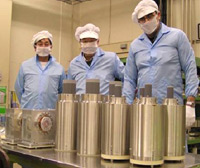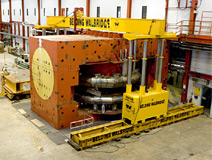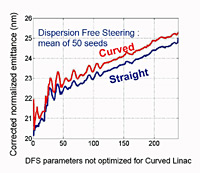Registration Filling Up for Single Crystal Workshop

A conveyor leads to a processing plant at the Araxá niobium mine. |
On 30 October to 1 November, the Single Crystal Niobium Technology Workshop will bring engineers, scientists and technicians together at the site of the world's largest niobium mine in Araxá, Brazil – an event that may be unique for accelerator history. The workshop will explore the manufacturing of large grain or single crystal niobium, a potentially cost-saving direction for superconducting radiofrequency (SRF) cavity technology.
Large grain or single crystal niobium may potentially reduce accelerator capital costs by eliminating certain expensive cavity surface treatments (See ILC NewsLine, 13 July 2006).
The workshop will be a forum for discussion on the current status of the technology for producing 280 mm diameter niobium single crystal ingots for large-scale high gradient applications of SRF linacs, such as the ILC.
Read more...
-- Ganapati Myneni, Jefferson Lab |
 |
|
|
 |
Upcoming meetings, conferences, workshops
2006 Linear Accelerator Conference
Knoxville, Tennessee, USA
21-25 August 2006 Linear Collider Physics School 2006
Ambleside, UK
14-19 September 2006
TTC Meeting (Tesla Technology Collaboration)
KEK (Information on schedule and logistics)
25-28 September 2006
9th International Workshop on Accelerator Alignment
Stanford Linear Accelerator Center
25-29 September 2006
The International Workshop on Thin Films
Legnaro, Padua (ITALY)
9-12 October 2006
EUDET Annual Meeting 2006
MPI Munich
18-20 October 2006
Single Crystal Niobium Technology Workshop (pdf)
Araxá mine in Brazil
30 October - 1 November 2006
Tentative Program (pdf)
Request Information (email)
ILC-ECFA Valencia Workshop
Valencia, Spain
6-10 November 2006
ILC GDE Meeting
Valencia, Spain
6-10 November 2006
USPAS
Texas A&M University
15-26 January 2007
The 9th ACFA ILC Physics and Detector Workshop & ILC GDE Meeting
IHEP, Beijing
4-7 February 2007
Annual WILGA Conference
Warsaw University of Technology Resort, Poland
21-27 May 2007
View Full Calendar...
GDE Meetings Calendar
|
|
 |
 |
|
|
 |
High Performance Coupler

The protection cases for the couplers and three KEK scientists (left to right: Hiroshi Matsumoto, Kenji Saito,and Sergey Kazakov) in the TOSHIBA clean room in Tochigi, Japan. |
At the ILC, electrons and positrons will be accelerated in superconducting cavities – tens of thousands of them. The cavities are surrounded by ultra-cold liquid helium (minus 271 degrees Celsius) in cryomodules, giant cold boxes to keep the cavities and liquid helium cold with a temperature difference of nearly 300 degrees Celsius over a distance of 60 cm. Yet each cavity has to be filled with powerful electromagnetic waves to give enough acceleration power to the electrons and positrons.
A klystron generates 500-kilowatt electromagnetic waves at a pulse width of 1.5 milliseconds, five times per second. This momentary energy amount is equal to turning on 1-kilowatt electric heaters in five hundreds houses at the same time. These waves have to be passed through the microwave duct into the cavities without causing significant power loss or wave reflections.
Read more...
-- Nobuko Kobayashi |
 |
|
|
 |
|

Make way for an ILC test beam! This week, workers began removing the Chicago Cyclotron magnet from the New Muon building at Fermilab. The giant magnet was originally part of the Chicago Cyclotron, made famous when Enrico Fermi and his colleagues at the University of Chicago used it to show that particles called "pions" are largely responsible for the force that holds protons together in the nucleus of an atom. Once the magnet is put out to pasture, work will begin to convert the building into a test beam facility for the ILC.
|
 |
|
|
 |
From Helmholtz Association
10 August 2006
Particle Physics Podcast
How did the Universe begin? What are the forces that hold the world together? What is matter made of? Researchers find answers to these questions with the help of enormous particle accelerators. A podcast about elementary particle physics and the origin of the universe (in German), including an interview with Rolf-Dieter Heuer (DESY).
Read more... |
|
From Popular Science
9 August 2006
Can This Machine Rescue Physics?
Suddenly the U.S. isn't the center of the physics universe. The answer: build the International Linear Collider—one of the most powerful (and expensive) pieces of equipment on Earth...
Read more... |
|
From From FYI: The AIP Bulletin of Science Policy News
7 August 2006
Orbach Sees Promising Future for Science at the Department of Energy
"Both the Senate and the House have expressed their confidence in you, the scientific community," Under Secretary for Science Ray Orbach told the Basic Energy Sciences Advisory Committee on August 3...
Read more... |
|
|
 |
More Reflections on VLCW06: The ILC Reference Design

A new study reported at Vancouver indicates that it may be possible to contain emittance growth in an earth’s curvature following main linac, which is our baseline configuration. |
Last week I discussed the physics and detector part of the joint American Linear Collider Planning Group (ALCPG) and GDE workshop (VLCW06) held in Vancouver from 19-23 July. The GDE portion of the meeting focused on preparations for the Reference Design Report and had very large participation -- about 200 scientists and engineers. Participants reported on important progress on the accelerator design, as well as success in obtaining a first-cut at the costing of most components for the baseline machine.
Read more...
-- Barry Barish
Director's Corner Archive |
 |
|
|
 |
EUDET Annual Meeting - Open for All!
The EUDET project, made up of 31 European institutes and by now 23 global associates, will hold its first Annual Meeting from 18 to 20 October 2006 at the Max-Planck-Institut für Physik in Munich, Germany.
After the successful Kick-off Meeting last February at DESY (see ILC Newsline article) which served to refine ideas and plans, the upcoming event will focus on the project's achievements of the first year.
EUDET is funded by the European Union and provides support for the development of vertexing, tracking and calorimeter prototypes as well as for the simulation and analysis software framework. The scientific programme is embedded in the international R&D efforts for ILC detectors, and several non-European institutes already contribute significantly to the project. Further development of the international collaboration is highly welcomed by the EUDET consortium to maximise the benefit for the ILC. Therefore the EUDET Annual Meeting is open to all interested people.
More information... |
|
|
Register for the Valencia ECFA/GDE Meeting
ILC-ECFA and the GDE will hold a joint meeting on 6-10 November 2006 in Valencia, Spain. The organising committee strongly recommends that participants register and book their hotel rooms as soon as possible.
More information... |
|
ILC Related Preprints
hep-ph/0607302
27 July 2006
TeV-scale Leptogenesis and Tri-bimaximal Neutrino Mixing in the Minimal Seesaw Model
hep-ex/0608001
31 July 2006
Machine-related backgrounds in the SiD Detector at ILC
hep-ph/0608065
4 August 2006
A. Bartl, H. Fraas, S. Hesselbach, K. Hohenwarter-Sodek, T. Kernreiter and G. Moortgat-Pick CP asymmetries in chargino production and decay: the three-body decay case
hep-ph/0608068
5 August 2006
A very narrow shadow extra z-boson at colliders |
|
|

